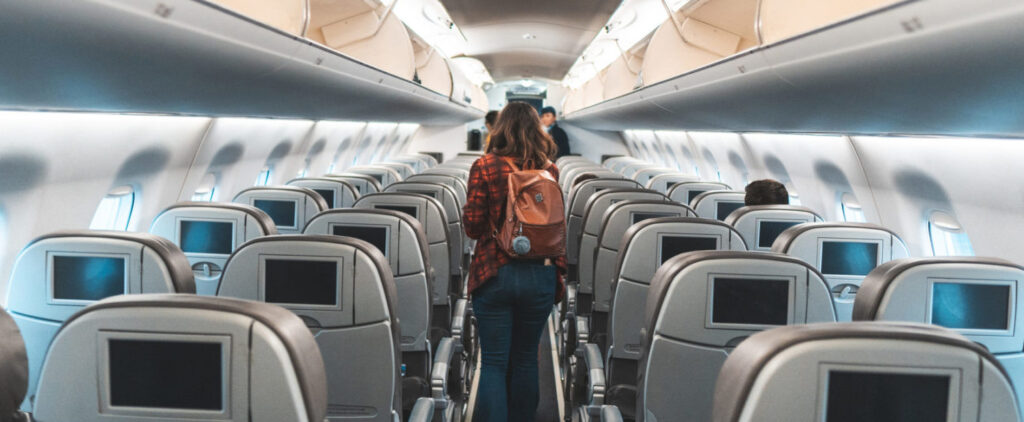6 WAYS TO STAY HEALTHY WHILE FLYING

After months at home, it’s natural to want to escape for a bit. However, the threat of the coronavirus is still very real and without a vaccine, it could take time before things go back to “normal.” The CDC advises against all non-essential international travel and warns that domestic travel “increases the chances of getting and spreading COVID-19.” Staying home is safest, but if you must travel or are determined to do so anyway, these tips can help make the journey as safe as possible. Nothing gets you to your destination faster than flying, but this convenience comes at a price — and your body may have to pay.
- Dehydration • The reason you get dehydrated in airplane cabins is because of the low-humidity level. Jets draw in 50% of the air circulating in the cabin from the outside, and that air lacks moisture. The obvious answer is to drink more water and refill a water bottle often. You should also wear glasses instead of contact lenses and your carry-on should contain lotion, eye drops, and nasal spray. Drink 3-5 ounces of water every hour you are on the flight.
- Swollen feet and ankles • Leg and foot swelling are very common during flights — you sit down too much, blood flow slows down and blood pools in your leg veins. That, combined with the extra pressure on your legs from sitting, leads to swelling. This is usually harmless and is easily taken care of by just getting up every hour or so and move around. Avoid wearing tight clothing and wear shoes you can loosen up or get out of during the flight. Pregnant women, people who’ve recently had surgery, and people who take certain medications are at a higher risk of swelling and experiencing complications (such as DVTs).
- Neck and back pain • Your spine was not designed to sit in an airplane for hours on end — it was designed to move. The C-shaped airplane seats aren’t an ideal position to be sitting in for long periods of time. They offer no lumbar support and with the limited space of airplane seats, it makes it difficult for you to switch positions often. It also reduces the recovery of your fatigued postural muscles and increases the load on your spine. Fortunately, when you can’t avoid those long plane trips, you can incorporate these tips for flying with back or neck pain. Bring a neck AND back pillow of some kind. You can get away with rolling up your jacket for the back pillow. Neck and back pillows are designed to support a natural position for your head and neck. They’re all made to provide your head and back with a natural resting position that maintains your spinal lordotic curves.
- Leg pain • When you’re stuck in an airplane seat, it shortens your:
- Hamstrings
- Hip flexors
- Lower back muscles
- Hip muscles (glutes and quads)
Your muscles become tight upon standing after being “shortened” for an extended period. Not to mention, because you were bending your legs for the whole trip, your blood wasn’t circulating properly and wasn’t nourishing your muscles, and this can also result in pain. If you have short legs like me, always travel with a folding footrest or hammock to support your feet.
Recommended Products:
- A folding step stool that is easily transportable in your carry on bag.
- A leg/foot sling.
- Food and Drinks • What you eat/drink will have a huge impact on the strength of your immune system. Avoid salty food as it will speed up dehydration. Eat healthy foods/snacks rich in fruits and vegetables as they contain all the vitamins and nutrients your body needs, while also hydrating you. You can also take Airborne (or Emergen-C) once a day for two to three days before and after the flight. These products provide a massive injection of vitamin C, among other vitamins, designed to give your immune system. Drinking alcohol during a flight can further speed up the process of dehydration that has already started. With lower levels of oxygen in your brain, the effects of alcohol are greatly increased, and your liver will begin working harder to process the toxins in your system. All of this further takes strength away from your immune system, making you more likely to contract something. Coffee is another drink that is best to skip while flying over because it speeds up dehydration. For a healthier option, try drinking tea instead.
- Hygiene • Airplanes are the nearly perfect environments for getting sick. They are enclosed spaces where people from all over the world are together for long periods of time. If that weren’t enough, factor in reduced oxygen and humidity from being at higher altitude. Even with pressurized cabins, the atmosphere in a plane can cause dehydration. This dries up the mucous membranes in our throat and nose that normally protect us from over 99% of the diseases we encounter in a normal day. Getting plenty of sleep before your flight is one of the best things you can do to make sure your immune system is performing at its peak. Try to get a solid seven to eight hours of sleep the night before. Bring sanitizing wipes and wash down seat belts, armrests, tray tables, seat pockets, seats/headrests, and entertainment touchscreens. Bring a pack of wipes to wash down the bathroom toilet seats, flush button, and sink faucets. Avoid touching your face and wash your hands often to help fight spreading germs. Wearing a mask is currently recommended.
